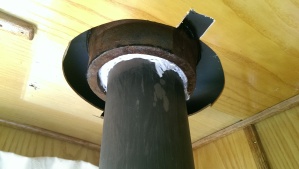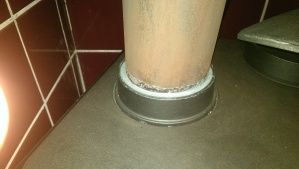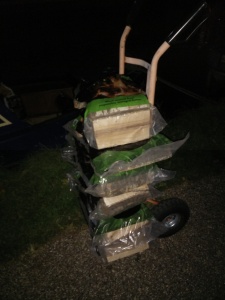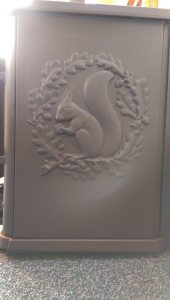Last winter I earmarked a lot of work that I wanted to do in Summer. Now summer is here and I’m still sitting on the sofa every night!
At least I’ve finally fitted the new Morso Squirrel (the pet!) that I had bought back in May at the Crick Boat Show for £250 below the usual price. While the job was quite straightforward this wouldn’t be on a boat if everything went ahead as planned!
First thing was to remove the old Boatman stove which was more than 15 years old and was one of the first that had been be built by Eddy. There wasn’t anything really wrong with it but it’s rather small and doesn’t take the usual wooden logs or at least not more than one.
To remove it I had to first get the flue pipe out which was cemented into the roof collar (which is made of cast iron and bolted onto the roof) and the collar on top of the stove. After undoing the stove’s retaining screws on the floor I started with rocking the old Boatman forth and back and sideways to loosen up the cement, then went on with picking the stuff out with a hammer and a small screwdriver. Finally the old fire rope, that made the seals gas tight and also held the pipe in place, were accessible and could be driven out.

That done the fluepipe could be lifted out through the roof. The rather light Boatman (30kg I reckon) was out on the frontdeck in no time, a quick post on the London Boater’s page on Facebook saw Tom coming around within 5 minutes and he picked it up for his boat where it’s going to serve appropriately in the boatman’s cabin in the back of his long boat. Time to put the much heavier (70kg) Squirrel into place and finish work for the day. The rain at night revealed that all that hammering on the roof collar had helped the old silicone sealant between the collar and the roof to loosen and let rain drip onto the new stove.
Next stop: taking off the roof collar. To access the bolts I had to cut out little bits of the roof lining which will later be covered by the original wooden plate. The collar came off with a little prying with a big screwdriver and revealed quite a bit of rust. I had expected this as there were always small amounts of water running down the fluepipe when it was raining heavily.
 So I removed the rust as good as I could with using coarse sanding paper and an old screwdriver for the bigger bits. Behind stayed a pitted surface… I painted two layers of iron oxide red primer, followed by two layers of a white undercoat, the collar itself also got the same treatment on the underside where it makes contact with the roof.
So I removed the rust as good as I could with using coarse sanding paper and an old screwdriver for the bigger bits. Behind stayed a pitted surface… I painted two layers of iron oxide red primer, followed by two layers of a white undercoat, the collar itself also got the same treatment on the underside where it makes contact with the roof.
After three days of painting and drying it was time to put everything back together. First the Squirrel had to be fixed in place to prevent it from moving when accidentally hit or when the boat hits something as that would also loosen the sealing cement on the flue and would lead to fumes coming out on the top of the stove, leaking lethal carbonmonoxide into the cabin. As the stove legs are not fitted with lugs or any form of fixtures and the stove only needs to be prevented from shifting (it’s too heavy to tilt, at least unless the boat isn’t being used on the Channel) I fitted sturdy plastic discs behind two legs that hold the cast iron box firmly in place. I’m not worried about them melting away as it normally won’t get hot enough underneath the stove.

 Next step was bolting the roof collar back in place which was easy enough to do, of course I applied a good amount of Plumba (a heat resistant silicone sealer, up to 250C which is enough at the top of the flue) around the cutout, the bolt holes and also around the circumference of the collar plate.
Next step was bolting the roof collar back in place which was easy enough to do, of course I applied a good amount of Plumba (a heat resistant silicone sealer, up to 250C which is enough at the top of the flue) around the cutout, the bolt holes and also around the circumference of the collar plate.

After inserting the flue pipe, which I had sanded down before for a later treatment with high heat resistant paint I fixed in place with different diameters of ceramic fire rope filling in the gap between the collars and the pipe.



When all was sufficiently sturdy I sealed the remaining gaps up to the top of the collars with fire cement (heat resistant up to 1250C) and smoothened the seals for a nicer look.
 Now only the wooden cover went back to the ceiling and also the decorative brass ring. Job done!
Now only the wooden cover went back to the ceiling and also the decorative brass ring. Job done!

Last thing to do will be painting the flue pipe but as the paint needs to be heated up in order to bind with the surface I’ll do that at a later point when the evenings start becoming chilly.
EDIT: I just found this post saved as a draft since about two months, I thought I had published it long ago! The fluepipe has been painted long since, all is fine. There’s much more room inside the stove for loads of – also bigger – logs. Spending the money on a Squirrel was apparently a good idea 🙂




















